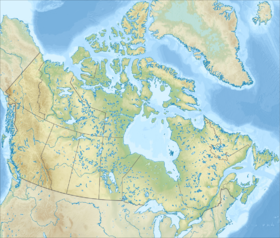The Banks (Banks Island, Banks Island ) is one of the largest islands of the Canadian Arctic Archipelago , ( ) located in the Inuvik Severo administrative district Western Territories , Canada .
| Banks | |
|---|---|
| English Banks island | |
 | |
| Specifications | |
| Square | 70 028 km² |
| Highest point | 730 m |
| Population | 114 people (2001) |
| Population density | 0 person / km² |
| Location | |
| Water area | Arctic Ocean |
| A country |
|
| Territory | Northwest Territories |
Content
Title History
Named in 1820 by Sir William Parry in honor of Sir Joseph Banks . However, during the exploration of the territory conducted by Robert McClure (1850-1854), the island was marked on his maps as “Baring Island”.
Geography
It is separated from Victoria Island in the east by the Prince of Wales Strait, and from the continent in the south by the Amundsen Bay . The Beaufort Sea lies to the west. In the northeast , the McClure Strait separates it from the Prince-Patrick and Melville Islands. Banks Island covers an area of 70,028 km²; it occupies 24th place in the world by area and 5th place in Canada. It is almost 380 km long and up to 290 km wide. The highest point on the island is located in the south, it is Durham Heights, which reaches a height of 730 m.
The largest rivers are the Thomsen, the Big River and the Bernard. The Big River and Bernard rivers flow westward into the Arctic Ocean , the Thomsen River northward into the McClure Strait. The large bays are De Saly (in the south-east), Tisiger (in the south-west), Burnet and Storkerson (in the west). Extreme points: Cape Alfred in the north-west, Cape Kellett in the south-west, Cape Lamton in the south, Cape Russell in the east and Cape Rotsley in the north.
Flora and fauna
Banks Island is located in two North American ecological regions allocated by the World Wildlife Fund - the Arctic tundra (eng. Arctic coastal tundra) and polar tundra (eng. Middle Arctic tundra).
There are no trees on Banks, the tallest plant on the island is arctic willow , which rarely reaches the height of the human knee, usually not higher than 10 cm.
In 1961, two migratory bird reserves were established on the island. In the north of the island is the Olavik National Park . Two thirds of the world population of the small white goose lives on Banks Island, geese fly to the island from the mainland through the Amundsen Strait. The island also has the highest concentration of musk oxen in the world - about 70 thousand individuals. The first batch of musk oxen for Taimyr was captured by Canadian zoologists in August 1974 on Fr. Banks. In the vicinity of Sax Harbor annual hunting is arranged on them. Here you can also find tundra caribou , polar bear and such birds as a wandering thrush and swallow .
It was here that for the first time in the world a hybrid of a white bear and a brown bear was found.
Population
The only permanent settlement of the Eskimos on the island is Sax Harbor or Ikhuak, located on the southwest coast.
See also
Canadian Arctic Archipelago
Literature
- Canada. Banks Island, a Natural Area of Canadian Significance . Natural area of Canadian significance. Ottawa: Parks Canada, 1978.
- Cotter, RC, and JE Hines. 2001. Breeding Biology of Banks Island, Northwest Territories, Canada. Arctic . 54: 357-366.
- Gajewski, K, R Mott, J Ritchie, and K Hadden. 2000. "Holocene Vegetation History of Banks Island, Northwest Territories, Canada." Canadian Journal of Botany . 78: 430-436.
- Holyoak, DT Notes on the Birds of Southwestern Banks Island, Northwest Territories, Canada . Bulletin of the British Ornithologists' Club, Vol.103, No.2, June. 1983
- Manning, TH, EO Höhn, and AH Macpherson. The Birds of Banks Island . 1956
- Stephens, LE, LW Sobczak, and ES Wainwright. Gravity Measurements on Banks Island, NWT . Gravity map series, no. 150. Ottawa: Dept. of Energy, Mines and Resources, Earth Physics Branch, 1972.
- Struzik, Ed. 2000. “THEN THERE'S WERE 84,000 - Beguiling Arctic Mystery”. International Wildlife . 30, no. 1: 28.
- Will, Richard T. Utilization of Banks Island Muskoxen by Nineteenth Century Copper Inuit . [Sl]: Boreal Institute for Northern Studies, 1983.
Links
- Historical sites of the Northwest Passage
- Map of the Northwest Passage (not available link) . Archived March 3, 2007.
- Banks Island at civilization.ca
